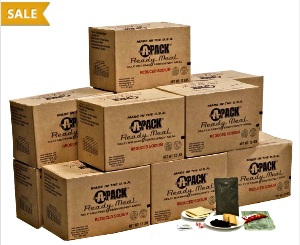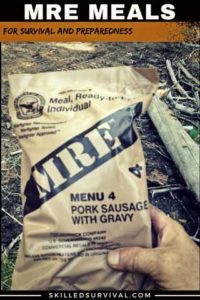
You see, MOST survival food tastes like wet cardboard. But there is one survival ration that tastes fairly good.
Dare I say…tasty (at least compared to other non-perishables). I’m talking about MREs.
They’re among the best, most nutritious, long-lasting survival foods. But before you buy, you must learn how to get a good deal & avoid making a mistake!
Best MRE Meals On The Market Today
Many food companies make survival rations, and many of them are similar. So it’s all about finding the best deals:
First off, The Ready Store is my go-to vendor of Military-Grade MREs.
Not only do they sell some of the top rations, but they do so in bulk and at a fair price.
The Ready Store sources from the same companies that supply the U.S. military.
I like that you can order small, medium, or large quantities with a single purchase, for example:
- 1 CASE (12 MEALS)
- 1 MONTH SUPPLY
- 3 MONTH SUPPLY
- 6 MONTH SUPPLY
- 1 YEAR SUPPLY
So you can have confidence in the "up to 5 years of the self-life, no cooking to consume, and MADE IN THE USA!
These genuine US warfighter rations offer about 1250 calories per meal.
These cases include flavorful spices, matches, toilet paper, and other survival accessories.
The meals are randomly selected from two different menu options but come with a variety of:
- Asian
- Mexican
- Italian
- Traditional
- Vegetarian
There’s even an assortment of snacks, desserts, coffee, milkshakes, and beverage powders.
While the packs have an inspection date of 2019, there is no official expiration date. This means they'll likely last about 5-7 years (or longer).
↓ Western Frontier’s Meals Ready To Eat, Case of 12
This pack has 12 entrees (not complete meals, just the main dishes), which helps bring the price down.
Or you could use these entrees to build out your own DIY MREs...
There are at least six different meal flavors included in this case. Some are chicken-based meals; others are beef-based.
This government-approved manufacturer guarantees quality products.
Another Western Frontier offering.
Instead of a case of 12, this is a 6-pack option.
These meals include flavorful spices, matches, toilet paper, and other survival accessories.
The meals are randomly selected from two different menu options but come with a variety of:
- Asian
- Mexican
- Italian
- Traditional
- Vegetarian
There’s even an assortment of snacks, desserts, coffee, milkshakes, and beverage powders.
This one claims a long shelf life if stored per the manufacturer's directions.
Again this option is good for hunting, camping, hiking, fishing, boating, and emergency food supply.
They are designed for maximum endurance and nutrition, averaging 1250 calories per meal.
This product contains 18 pouches of Beef & Chicken Entrees.
3 Shredded Beef, 3 Beef Strips, 3 Beef Ravioli, 3 Chili with Beans, 3 Meatballs, 1 Chicken noodle, and 2 Chicken Chunks.
All are 8 oz, except Chicken Chunks (5 oz).
Includes labels or cardboard sleeves with Ingredients and Nutritional Information.
↓ Review 2021 Humanitarian Daily Ration!
Best MRE Ration Taste Tests
Here are a few review videos worth watching:
↓ 2Chicken Burrito Bowl Meal Ready to Eat Review
↓ Ultimate Rations Taste Test
↓ MRE Review – Menu 10 – Chili and Macaroni
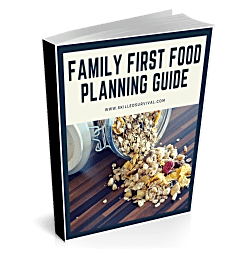
Want a free family-first food planning guide?
Enter your email below to instantly download this Complete Guide PDF. No purchase necessary. 👇 👇What Is A Meal Ready To Eat & How Are They Made?
Meals Ready to Eat, as in, it’s ready to eat straight out of the packaging. They come in sealed, airtight packs to prevent drying out or going bad.
The United States military originally designed these survival rations. They were developed in the late 1970s and early 1980s.
They replaced the MCI rations (Meal, Combat, Individual rations). MCI rations were the ones used throughout WWI and WWII. And are still in use today…
↓ Eating Rations At Officer Training School
MRE kits are lighter in weight, cheaper, and easier to transport. And more nutritious than MCIs. They were made for soldiers on the move away from mess halls. And they kept those warriors fed and living to fight another day.
While these rations are relatively new, the need for portable, nonperishable food goes back thousands of years.
“The generally awful reputation of military food dates to ancient times.” – Rebecca Rupp
Providing nutritious food for soldiers has been an epic challenge throughout history. The logistics of keeping an army fed made the difference between winning a war or losing it!
↓ The Evolution Of Military Rations Throughout History
One of the ancient options was to scavenge the local areas. Depleting farmers and small towns of their meager food supplies.
This practice was frowned upon back then and even more so today. Modern-day armies now feed an army without stealing from civilians. MREs are a modern solution to this ancient problem.
↓ History Channel – Battle Factory (Meal Ready to Eat)
How Are They Made?
↓ How Do You Make An MRE? Go Inside The Test Kitchen
Mass Popularity
With their insane utility, they’ve become popular in the civilian world:
- Hunters
- Backpackers
- Campers
- Hikers
- Bikers
- Fishermen
- Etc.
They’re one of the most popular forms of survival food today. Even humanitarian and government disaster response groups have adopted MRE food.
They hand them out to victims of natural disasters and emergencies. So stock up because after a crisis, they won’t be as cheap and abundant.
↓ 5 Things You Don’t Know About: Rations
What Makes Them Worth Buying
How Long Are MREs Good For?
They can last for up to seven years. And if kept in cool, dry conditions, they can last even longer.
Theoretically, if you freeze them, they’ll last indefinitely. This shelf life makes them a good choice for emergencies.
You can store them with your survival gear, in your food cache, car or bug-out location! And they’ll be good when you return to eat them later.
They’re Relatively Cheap
Most of the time, you’ll find these meals in bulk. Usually between four and twenty meals per bundle. And the more you buy, the cheaper they are individually.
A single ration costs around $20. But buying a package of twelve will cost closer to $10 or $12 each.
That’s a great incentive to buy in bulk. Plus, the more you have, the better off you’ll be in a crisis.
Transportation & Portability
These things were designed to be carried by soldiers over long distances. So, weight and packability are significant factors.
They’re engineered to be light while still packing a nutritional punch. And they’re easily stored in a backpack, glove box, or pocket.
No spilling, molding, or mess. And they taste damn good for military MREs.
Unlike other non-perishable meals, these things DO NOT taste like dried cardboard caked in mud.
Many companies offer different meals and flavors. So finding the meals you’ll enjoy is not difficult.
Some offer full menus (with a variety of flavors), such as:
- Main Course Entrée (i.e., beef stew or chili mac or cheese tortellini)
- Side Dish (i.e., rice, corn, mashed potatoes, etc.)
- Sandwich Bread Or Crackers
- Spread – (i.e., peanut butter, jelly, or cheese spread)
- Desserts and snacks (i.e., cookies or pound cake)
- Candy (i.e., M&Ms, Skittles, or Tootsie Rolls)
- Hot Sauce or Seasoning Packets
- Powdered Drink Mix
- Flame Ration Heater (for the entrée)
- Accessories—(e.g., spoon, matches, creamer, sugar, salt, chewing gum, toilet paper, etc.)
These rations make survival a tasty experience. Being in an IT-hits-the-fan scenario does not mean you have to eat crappy food.
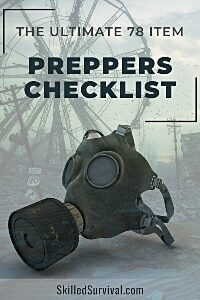
Want a free 78 item preppers checklist?
Enter your email below to instantly download this Complete Checklist PDF. No purchase necessary. 👇 👇How To Heat Your Rations
Of course, as the name implies, you can immediately open and start chomping away. But most people suggest you heat the meal before consuming it.
There’s nothing wrong with eating them cold and fresh from the wrapper. But most folks enjoy them warmed up.
Flameless Retention Heater
These nifty little ovens were explicitly designed for these survival rations. If yours includes a heating method, it will likely be a flameless retention heater. It works without matches, tinder, or fuel.
Just slip your ration inside the heater pouch and add a teaspoon of water.
Now, sit back and let the magic unfold.
The water starts a reaction inside the pack and generates heat to warm your meal in minutes.
↓ How Air-Activated Heaters Work
Boiling Water
Most are packaged in a material that is both water and heat-resistant. So boiling them is an option. And it’s an easy, efficient method for heating your food.
Allow some water to boil in a pot, then reduce the heat to a simmer.
Place the ration inside the boiling water and soak for 5-8 minutes. Pull it out carefully, and you’ve got a hot and ready meal! This method is particularly useful in survival situations.
That way, you don’t require a fancy chemical heating package or a portable butane stove.
The Saucepan
Get your hands on a saucepan and a heat source (a fire will do, but a stovetop is better). Open the package, pour the contents into the saucepan, and heat it to the desired temperature. DONE!
The Oven
If you can access an oven (rare in actual survival), you can use it to warm up your rations.
Just get an oven-safe pan, open it, and cook it at 350 degrees. It takes about ten minutes.
Maintaining Your Stockpile
Unfortunately, no survival meal is going to be kept indefinitely. Even military-designed, long-lasting rations come with an expiration date.
Knowing this, you must monitor when they might go bad.
The last thing you want is to bust into your survival food rations only to get food poisoning.
The food you were counting on to stay fresh. Do not let it happen!
The problem is: It can be difficult to monitor foods that last up to 7 years.
It’s difficult to know the precise date when it goes from safe to eat to poison. You can’t mark an exact date on your calendar.
So what do you do?
You should keep a running list of what you have / when you got it. You should record its manufacture date and when it’s likely to go bad. A simple spreadsheet will suffice.
Mine is on a clipboard I reference whenever I add something new to my survival food supply. Be it canned foods, dehydrated goods, bottled water, or food. Then, when some of your foods expire, you can single those out.
Eat MREs before they go bad, and then replace them.
This way, you cycle through the older food supplies and always have fresh survival ones. Also, remember where you store them makes a big difference. Don’t expect them to last if you stash them on a windowsill in direct sunlight.
They won’t be good when you eat them. Cool, dark, dry areas are best for storing MREs – think root cellar.
You can help them to last even longer just by where you store them. Pantries, temperature-controlled garages, basements, and closets all work well for this.

Want a free family-first food planning guide?
Enter your email below to instantly download this Complete Guide PDF. No purchase necessary. 👇 👇DIY MREs – Make Your Own For Cheap
If you’re like me, you’re willing to put in some time and effort to save a few dollars. Well, the best way to do this is to make your own!
↓ How to Make Real Rations for Under $5
Final Thoughts
Adding MREs to your survival food stockpile is a major step towards self-reliance. They ensure that, no matter what happens, you’ll have calories to consume.
That way, when the moment finally comes, you won’t be the family that goes hungry.

Prepare, Adapt & Overcome,
P.s. - I just found out 2 out of 3 Americans don’t feel prepared for a 3 day disaster!!!
I guess this goes to show how modern society continues to embrace ‘living a fragile life.’ What’s crazy is… it’s so easy to fix.
To make sure YOU have the basics, watch our FREE training on “10 Simple Steps To Basic Preparedness” that shows you HOW.
Nothing crazy here… this isn’t doomsday prepping... just the basics every responsible adult should have before a disaster strikes.Why You Can Trust Skilled Survival...
Go here now to review a full breakdown of:
- Who We Are
- Our Credentials
- Our Mission
- & Product Recommendations...
Here are a few highlights of our teams credentials & certifications:
- Certified Member of a Mountain Search & Rescue Organization
- Plant Emergency & Safety Leader for a Major Food Manufacturer
- Member of the 10TH Mountain Division Hut Association
- Certifications: Avalanche 1, WFR, CPR
- Official Gear Tester for Numerous Outdoor Gear Companies
- Countless Multiday Backpacking trips into Remote Wilderness
- Bachelor's Degree In Mechanical Engineering
- Bachelor's Degree In Civil Engineering
- Bachelor's Degree In Biomedical Engineering
"It takes 20 years to build a reputation and five minutes to ruin it." - Warren Buffett
We're fully aware that trust is NOT something you GET but is EARNED.
And we'll continue to earn YOUR trust through our forthright and honest approach with each new Blog Post, Guide & Product we create...
P.s - I just took this FREE 60-second 'Readiness Score Quiz'👇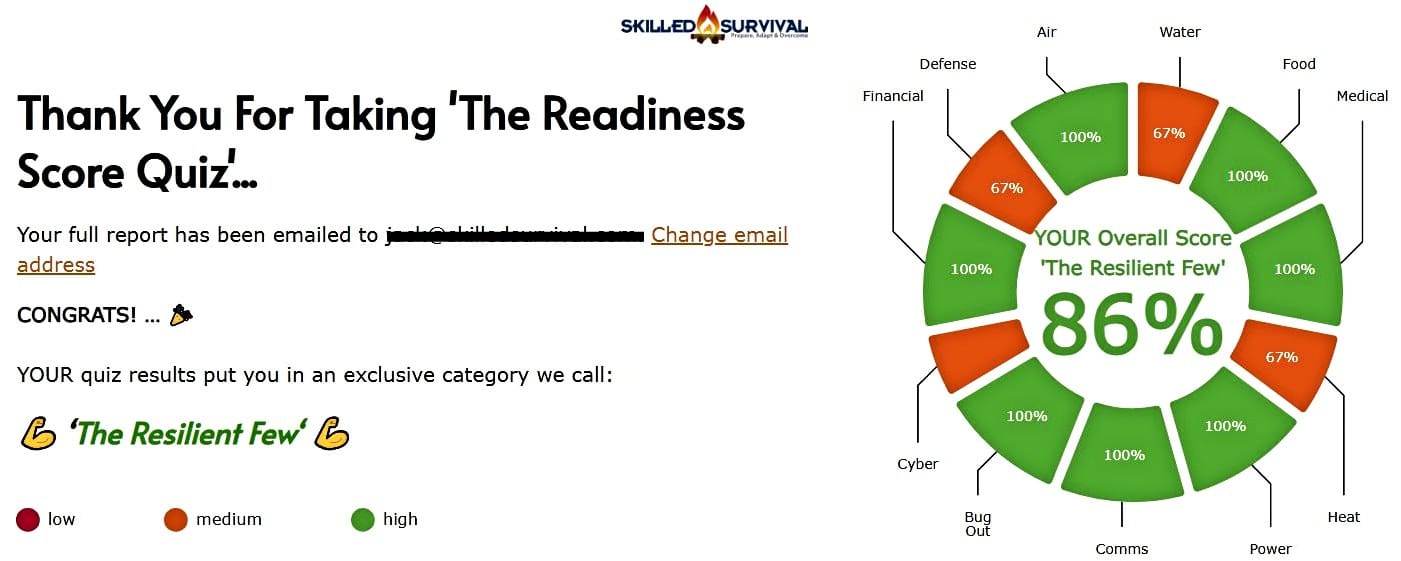
AND... I've still got a few gaps in my preps...🤔 But at least, I'm not part of 'The Fragile Masses'. 👍 Find out where YOU stand by answering a few questions...
Top Image

Recommended Reading
Emergency Food Storage When Calories Become Scarce
Building your emergency food storage doesn't have to be complicated. We break things down into simple steps to help you do it right.
The Most Nutritious Survival Foods You’ll Actually Love
What are the best survival foods? It depends on your goals. We look at different scenarios to help you stockpile the best emergency foods.
Dehydrating Fruit: How To Preserve Sweet Calories
Dehydrating fruit is a great way to store tasty calories for long-term storage. We should you the best way to dehydrate some for emergencies.
Unique Food Storage Ideas: The Most Surprising Locations
Want a large emergency food stockpile but living in cramped quarters? Don't let this ruin your preparedness passion! Try these unique food storage ideas.
Prepper Food: Best Ones to Stockpile For Emergencies
What's the worst-case scenario if you choose NOT to stockpile any food? Starvation. That's why investing in prepper food is so wise.
Valley Food Storage Review: An Expert Puts It To The Test
Unbiased and thorough Valley Food Storage review covering food supplies, packaging, taste, and shelf life. Don't buy without reading this...

